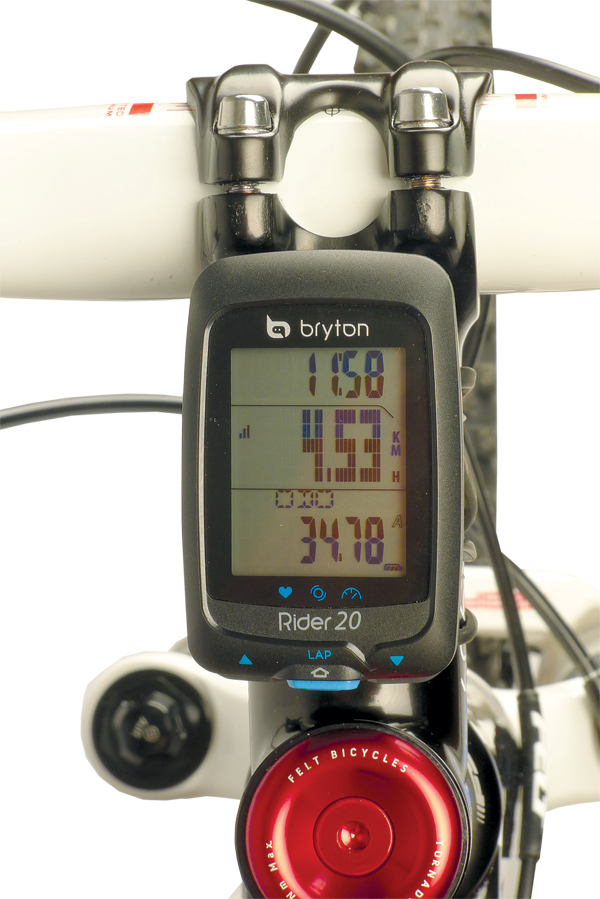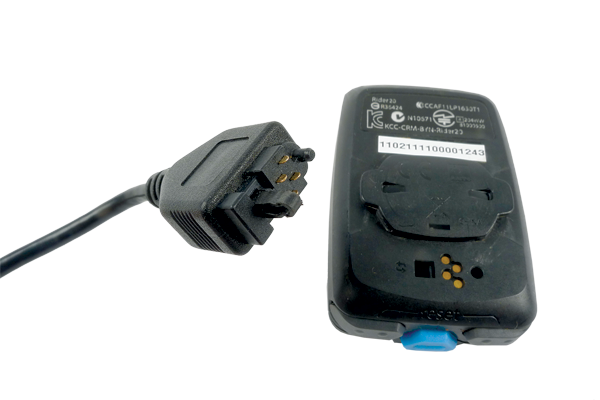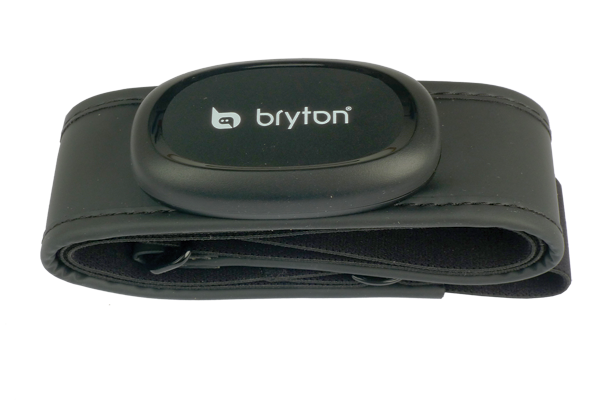Bryton Rider 20
 Of late, cycling specificGPSdevices have been shrinking. They started out as all-singing-all-dancing navigational instruments that took up a good chunk of your handlebar real estate, but now the major brands are offering far more compact devices that forgo the mapping and navigational features.
Of late, cycling specificGPSdevices have been shrinking. They started out as all-singing-all-dancing navigational instruments that took up a good chunk of your handlebar real estate, but now the major brands are offering far more compact devices that forgo the mapping and navigational features.
The Rider 20 is the newest device from Bryton and it certainly fits the bill as being compact. Measuring 63x40x19mm it’s close to the size of a standard cordless cycle computer, and with the base unit selling for $129 (without heart rate), it’s in the same general price area as a good traditional cycle computer.
What’s the point of aGPSthat doesn’t offer any navigational features? One of my favourite things is the ease of fitting; no need for fork mounted sensors and wheel magnets, just strap it on and go. Swapping between bikes takes a handful of seconds and there’s no need to calibrate for differing wheel sizes.
Like most currentGPSdevices, the Rider 20 can record your ride and upload the data to a web-based database. Once uploaded to www.brytonsport.com you get to see an impressive array of information about your ride; there’s an overview map (with contour info), elevation graph, total cumulative climb and descent, maximum altitude as well as slightly dubious ‘calories burned’ stats. If you go for the $175 Rider 20 HR bundle, you’ll also get a wireless strap and all of your heart rate information will be included in the online ride stats.

Uploading the data requires the ‘Bryton Sport’ program to be loaded on your computer; not a major hassle but it isn’t as simple as the Garmin equivalent, which allows you to upload directly to their database from any computer—no special software required. At least Bryton is now up to speed with offering the Bryton Sport program for both Mac and PC users.
Connected & Addicted
Nitpicking aside, the ability to upload and store ride information is both handy and addictive—something you just don’t get with an old school cycle computer. You can even extract theGPXfiles from Bryton Sport and upload them to other sites such as Strava—before you know it you’ll be competing against your online buddies, with your local trails turning into a virtual race track every time you go for a pedal!
While the online autopsy provides a wealth of data, the on-screen information is pretty basic. The three-line display offers current speed in the middle, ride time or trip time on the top line and your choice of distance, heart rate or calorie consumption data at the bottom. Post ride, the on-screen display offers up a little more data (average and maximum speed amongst other things), but I never really looked at this as I’d generally upload the ride log after each outing. Bryton’s claimed battery life of 18 hours never presented any issues and the screen has a really effective backlight for any night-time adventures.

The general simplicity and compact dimensions of the head unit will definitely appeal to some. I for one never looked at half the information on more elaborate devices when out on the trail—that’s what you do with a beer in hand at home before sharing it with your mates. The only thing I really wished for is the ability to show current speed, trip distance and heart rate simultaneously on the tri-level display (this isn’t possible as the top line only shows the time data).
With no built-in altimeter, you will encounter loss of accuracy in the climbing data when compared with something like the Rider 30. On rides with a Rider 30 user, I finished with around 20-30% more total elevation gain over the same course. The total climbing is interpolated from online mapping data; it thinks you descent and climb through every creek and gully, which accumulates over the ride to produce an inflated figure, with no moderation from an altimeter. Again it’s not perfect but still far more interesting and versatile than a standard cycle computer.
Proprietary Plugs
The overall lack of complexity can’t be criticised, however the Rider 20 does present two more annoying issues. Where the more expensive Bryton units connect to your computer via a commonUSBplug, the Rider 20 uses what appears to be a proprietary fitting. Even if it isn’t proprietary to Bryton, it’s certainly not a plug that I’ve seen anywhere else. You’ll need to have the special connection on hand whenever you need to upload or charge the unit—no plugging it in for a quick charge at work unless you buy an extra power cord to have at the office. Why use such an odd fitting? Apparently the fitting is watertight; something you don’t reliably get with aUSBplug. While it is said to be waterproof, I did have quite a bit of condensation inside my screen after a few months of wet and muddy riding.
The handlebar mount was the second source of frustration—a design shared with the Bryton Rider 30 but not the fully-featured Rider 50. While the rubber O-ring mounted bracket works well, allowing tool-free stem or handlebar mounting, the twist-mount on the head unit proved insecure. It only took a minor knock to dislodge the head unit and I lost the Rider 20 on two occasions—once when lifting my bike over a gate and the other in general riding. Both times I was lucky to find it but heed my advice and take care not to lose the Rider 20 on the trail.
For around to the price of a good cordless cycle computer you get a device that’s far more versatile and opens up all the addictive perks of the onlineGPSnetworks. It’s compact, relatively hassle free and very easy to use. Sure it has some issues to be wary of but for the money it’s really hard to fault the Rider 20.
Oceania Bicycles (03) 9799 4144 / www.brytonsport.com


 Of late, cycling specificGPSdevices have been shrinking. They started out as all-singing-all-dancing navigational instruments that took up a good chunk of your handlebar real estate, but now the major brands are offering far more compact devices that forgo the mapping and navigational features.
Of late, cycling specificGPSdevices have been shrinking. They started out as all-singing-all-dancing navigational instruments that took up a good chunk of your handlebar real estate, but now the major brands are offering far more compact devices that forgo the mapping and navigational features.

